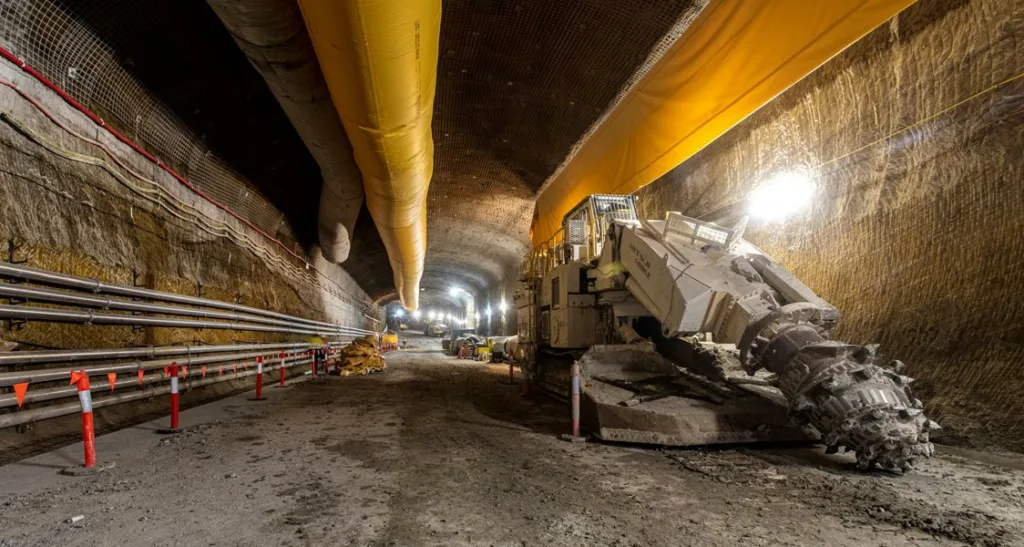In recent years, innovative approaches have brought about a fundamental transformation in tunnel construction methods. This transformation has been driven by the need to meet increasingly tighter project deadlines. As a result, there has been a notable adoption of creative methods and technologies, encompassing improvements in materials, machinery, and the integration of intelligent digital solutions. A recent example of this progress is the extension of the WestConnex M4-M5 Link Tunnels, which was completed ahead of schedule. This remarkable achievement was made possible through the application of advanced mechanical and electrical engineering, the implementation of advanced control systems, and the utilization of innovative shotcrete techniques.
About the WestConnex M4-M5 Link Tunnels Project
The main goal of the WestConnex M4-M5 Link Tunnel project is to connect two major motorways, the M4 East at Haberfield and the New M5 (now known as M8) at St Peters in Sydney, Australia. It plays a key role in the broader WestConnex project, which seeks to enhance Sydney’s road network and improve overall traffic flow throughout the metropolitan area.

Mechanical and electrical engineering of WestConnex tunnel
The project entailed extensive mechanical and electrical engineering (M&E) efforts, encompassing the installation of two surface substations, four underground substations, two low point sumps, two ventilation structures, ventilation tunnels, various electrical equipment rooms, cross passages, and in-tunnel devices. All these components needed to be set up and connected to the WestConnex Motorway Control Centre.
To ensure smooth progress, a “tunnel production line” concept was adopted right from the project’s inception. The process required meticulous maintenance of a clean tunnel environment. After each bench excavation, a 100 mm layer of temporary blinding concrete was applied, despite the associated additional cost. This practice effectively ensured that the tunnels remained free of mud, enabling both civil and M&E works to progress according to plan, with operational efficiency.
As explained by Marsonet, the Acciona Project Director, “We would begin with a 1 km excavation zone, encompassing both the heading and benching at the front. Following this, we moved into a zone dedicated to civil works, involving tasks such as drainage, paving, barriers, and waterproofing. Subsequently, we had a zone dedicated to M&E installation works”. “This arrangement allowed for a seamless view, where you could stand on concrete paving and observe excavation works ahead, then turn around 180 degrees to witness M&E fit-out works,” he further added.
Marsonet also elaborated on the careful logistics planning, especially in the underground sections. It was essential to ensure that all fit-out activities could continue uninterrupted even as dump trucks passed by, and concrete trucks entered and exited the tunnel.
Challenge for Mechanical and electrical engineering work
Initially, not everyone on the project was confident this method would work, so the leaders had to convince them. Marsonet said, “The M&E team had doubts about our ability to manage air quality, waste, and concrete logistics for a clean working environment.” To address these concerns, they used simulations and videos to demonstrate how the underground logistics would function. They also made sure the M&E team had enough time to carry out their work properly, boosting morale among team members.


In addition to the Mechanical and Electrical engineering work, another significant feature of the project was the use of the Integrating Operational Management Control System.
What is an Integrating Operational Management Control System (IOMCS)?
An Integrating Operational Management Control System (IOMCS) is like the brain of a tunnel, ensuring everything runs smoothly and safely. It constantly monitors the tunnel’s operations, like traffic flow, and can adjust things like speed limits, control who enters, and manage traffic signals at the tunnel entrances and exit. . In the event of an accident, fire, or emergency, the IOMCS plays a crucial role by providing vital information to emergency responders, helping them respond quickly and effectively.


Integrated OMCS (IOMCS) system for WestConnex tunnels
In the case of the WestConnex tunnel, a special IOMCS system provided by SICE has been used.Each tunnel has its own IOMCS that handles safety, traffic, and emergencies. Additionally, there’s a central IOMCS that oversees all tunnels from a control room. This means that if something goes wrong in one tunnel, like the M8, all tunnels can issue warnings or make traffic adjustments as needed, either automatically or through manual control. They extensively tested this system, and it has performed flawlessly from the beginning.
SICE’s IOMCS system, along with their OMCS solution called SIDERA and other advanced transportation systems, ensures the entire WestConnex tunnel network operates smoothly. It manages various devices, like signs, fans, and emergency phones. Importantly, it’s designed to handle even more tunnels in the future because it can expand and adapt.Remarkably, it’s the one most advanced road control system in Australia and is designed to handle more tunnels in the future, as it can expand and adapt.
A team of over 160 engineers from Spain and Australia collaborated closely with project partners to successfully implement this system ahead of schedule. They dedicated over 120,000 hours to testing more than 14,300 tunnel devices during the project’s commissioning stage.
Tunnel ventilation For Healthier Environment
The WestConnex tunnel project places a strong focus on ensuring the health of local communities and tunnel users by paying careful attention to tunnel ventilation. They aim to keep the air inside the tunnels clean and safe. To achieve this, the project has implemented a robust air quality monitoring program within the tunnels and advanced ventilation systems.
These tunnels have some notable features. They are designed to be wider, flatter, and taller, which means driving through them should be smoother with fewer stops and starts. This design helps reduce traffic jams on the surface and lowers vehicle emissions, ultimately making the air cleaner for everyone.
An Innovative Shotcrete Design
Acciona Project Director Andrew Marsonet and Leo-Paul Calbrix, a civil engineer at Bouygues who was the design manager on the project came together in creating an innovative shotcrete design. The design focused on using new materials and structural techniques. The goal was to find a balance between optimization and meeting the requirements set by Transport for New South Wales.

This involved optimizing how rock bolts and shotcrete, which stabilize tunnels, work together. The team introduced handlebar plates with studs to create strong connections between the shotcrete and rock bolts, ensuring efficient load transfer. This design met the requirement of not relying solely on the long-term adhesion of shotcrete to the rock.
Leo-Paul Calbrix, a civil engineer at Bouygues and the project’s design manager, explained that by combining rock bolts with shotcrete, they achieved strength and avoided the need for an overly thick shotcrete arch.
They managed to reduce the standard shotcrete thickness from 110 mm to 100 mm while maintaining the same level of performance. Additionally, they used up to 25 percent fly ash as a substitute for cement in the shotcrete mix. This not only improved the shotcrete’s durability but also had a positive impact on the environment.
This approach brought several benefits, including cost savings of more than $10 million, a significant reduction in carbon emissions, and increased productivity. The innovative shotcrete design even received international recognition, with the American Shotcrete Society awarding the WestConnex M4-M5 Link Tunnels project the 2022 Outstanding International Shotcrete Project of the Year.
Conclusion:
This tunnel project represents a significant change in how tunnels are built. It’s all about pushing the boundaries of innovation. By being open to creative solutions, this project didn’t just make construction faster and better; it also set a path towards a more environmentally friendly and safer future in tunnel engineering. This groundbreaking approach is likely to inspire future tunnel projects and represents a major step forward in how the industry evolves.
References- createdigital.org.au, arcadis.com, www.sice.com, westconnex.com.au, aurecongroup.com



